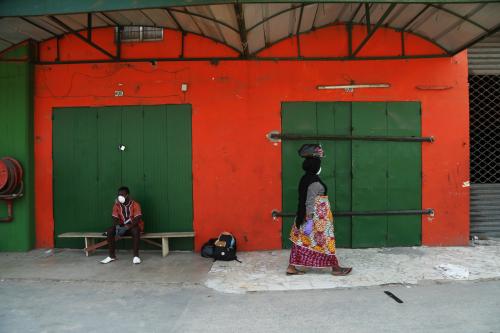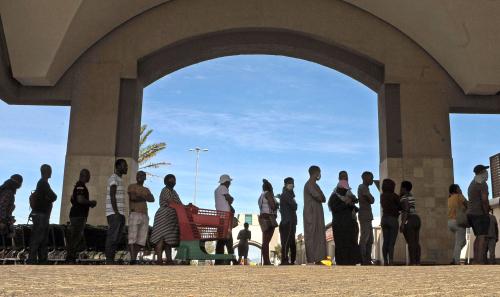In the run-up to this week’s Virtual Spring Meetings, the International Monetary Fund (IMF) has stepped up and provided much-needed leadership to assure countries and financial markets that they have the resources and tools necessary to help address the worst global economic crisis since the institution was created in 1945. But, precisely because the IMF is moving so aggressively to provide vital emergency support to countries seeking assistance, it is at risk of sometimes using overly optimistic assumptions to allow it to do so, finding some countries’ debt to be sustainable when, in fact, the COVID-19 crisis presents such vast uncertainty that no one knows whether it really is.
Rather than attempting to define as “sustainable” what could more fairly be classified as “uncertain,” we suggest that the IMF modify its lending policy to allow use of its emergency instruments into uncertain debt sustainability during a global or systemic crisis. This would afford countries a more transparent window into the risks they face, while still receiving the benefit of IMF financial support during this crisis. It would also provide private investors with a more realistic assessment of a country’s debt repayment prospects, avoiding the situation in which policymakers could ask investors to participate in a debt standstill or restructuring, while the IMF is simultaneously asserting that the country’s debt is nevertheless sustainable. The IMF would maintain all current sustainability requirements for conditions-based programs. The introduction of this more flexible approach would apply only to the IMF’s emergency support instruments, and thus would not likely increase the likelihood of moral hazard abuse
IMF emergency instruments
Today, over 90 countries have already sought IMF support under its Rapid Financing Instrument (RFI) and Rapid Credit Facility (RCF) emergency instruments. To respond to the emergency nature of crisis requests, this past week the IMF doubled the access limits of these facilities, making potentially $100 billion available to those in desperate need of financial support. Under current policy, the IMF can only provide those emergency funds if a country’s debt burden is found to be “sustainable.” That sustainability threshold is determined by IMF staff, who generally undertake a Public Debt Sustainability Analysis (DSA), in order to analyze a country’s current and projected economic performance, fiscal policies, and debt exposures by running those figures through a standardized model. The output of the DSA determines whether that country’s debt is sustainable or not. In the context of the RFI and RCF, the outcome is binary. A country’s debt either is sustainable or it is not. (This differs from large country programs, where, under the IMF’s Exceptional Access Policy, countries can fall into an uncertain area known as the “gray zone,” where their debt is considered sustainable, but without the required degree of confidence.)
In creating an IMF DSA, there can be a fair amount of discretion applied—a balance between art and science, with slight adjustments potentially altering binary outcomes. The art of the DSA is especially important for those countries where debt sustainability is too uncertain to determine with any real degree of confidence. Given that the COVID-19 crisis presents economists with unprecedented uncertainty in projecting economic outcomes, we suspect that an honest assessment of the debt sustainability of many countries currently requesting assistance would tilt more heavily into art over science, so as to attain the desired outcome of providing necessary support.
Rather than asking IMF staff to err on the side of potentially unwarranted optimism about economic risks, it would be better to ask IMF members to reinterpret lending requirements to allow for emergency lending, limited to the unique circumstances presented by this global crisis, to countries whose debt is found to be something other than sustainable. Those countries whose debt burdens were found to be unsustainable would continue to be prohibited from access to IMF funds absent measures to make the debt sustainable, but to those whose prospects are closer to the line, but simply too uncertain to assess, this approach would allow both creditors and countries the benefit of unadulterated IMF expert analysis, while still allowing the provision of IMF emergency support.
Purpose of IMF sustainability requirements
The IMF’s general policy requirement for finding that debt is sustainable before putting IMF resources at risk is understandable. The IMF is a lending institution, not a grant-making one. Its 189 member countries all provide publicly-sourced financial commitments to the IMF through various facilities. The IMF is primarily funded through its “quota,” which represents all member countries’ share of the IMF’s basic financing resource pool and is roughly based on each country’s share of the global economy. In addition to quota, the IMF can draw on two additional pools of resources: the New Arrangements to Borrow (NAB) and a series of coordinated bilateral country credit lines called Bilateral Borrowing Arrangements (BBAs). Together these financial commitments represent roughly $1 trillion of resources. Ensuring that those public financial commitments are protected through strict financial safeguards has been central to the way the IMF has operated since its inception. Those who believe the IMF squanders taxpayer funds with little oversight could not be more mistaken. In fact, the IMF has strong financial safeguards and benefits from preferred creditor status, which prioritizes repayment to the IMF over that of all other private creditors and bilateral lenders.
Requiring debt sustainability also serves the interests of countries seeking IMF support. By requiring that debt is found to be sustainable before incurring more, it deters the buildup of unsustainable debts that are not likely to be repaid without more significant damage to the debtor country. This could result in forcing tighter austerity measures and hardship on the people allegedly being helped, and damaging the creditworthiness of the country, potentially increasing borrowing costs, or shutting down market access altogether.
Ordinarily, if a country’s debt is not found to be sustainable, the IMF can insist on measures to assure it will be repaid. For example, if other sources of funding remain available to fill gaps, the IMF can require that other funding be assured so that IMF funds remain safeguarded. In nonemergency program countries, the IMF will often request that the country undertake policy reforms that allow the country to reach a more sustainable equilibrium, allowing it to pay its debts while continuing to grow. Countries often use the IMF as a tool to allow them to undertake necessary, though politically unpopular economic reforms, with the IMF taking the “blame” for making its support contingent on undertaking those reforms.
Today, however, those normal processes do not apply. Market access for low-income and emerging markets is at best speculative and bilateral borrowing from countries enduring their own domestic stress is likely to be less forthcoming. Likewise, normal IMF conditionality around fiscal belt-tightening, structural reforms or other policy adjustments are inappropriate at a time when countries are focused on using already limited fiscal and monetary tools for immediate COVID-19 crisis response.
When neither policy adjustments nor ongoing financial support from other sources are available, the IMF would traditionally look for other ways to achieve debt sustainability, often seeking to address the country’s public debt burden, either by reducing the stock of debt or by making the servicing of that debt more manageable. There are currently growing calls by the G-20, International Financial Institutions, leading public figures, and the leading finance industry association—the Institute for International Finance—for both bilateral official sector and private creditors to consider offering debt relief to low-income and to some emerging market countries. These efforts may be necessary, but are also potentially painful, raising questions of inter-creditor equity, as well as whether the complexities of resolving disparate creditor interests, legal issues, and the likely time required to undertake those debt operations could delay much-needed emergency assistance.
Flexibility in assessing debt sustainability
IMF economists are experts; they are not clairvoyants. Given the breadth of possible outcomes over the coming months and years, the most realistic assessment of some countries seeking support would be to declare their debt sustainability prospects as uncertain. Lacking that option, in some instances, IMF staff are likely to feel pressure to predict shorter and shallower impacts of COVID-19 followed by faster and steeper recoveries, thus ensuring that the IMF can play its role as emergency lender of last resort, but finding debt sustainability where, in fact, the reality is more uncertain.
Finding debt sustainability across a wide swath of the developing world would allow the IMF to provide emergency support in a rapid time frame to countries in need. Doing so by potentially providing overly optimistic assessments of risks to individual countries, no matter how well intended, however, could weaken the integrity of its economic forecasts and analysis. This could ultimately make countries’ debts less—not more—sustainable, postpone necessary measures, more deeply subordinate investors, and increase the risks of a deeper, more destabilizing restructuring later, when the reality of inflated assumptions is revealed.
Including more flexibility in assessing debt sustainability in the IMF’s emergency lending instruments would allow the IMF to provide an honest and more realistic assessment of countries’ likely ability to emerge from the current (and any future) crisis and to allow officials, policymakers, creditors, and financial markets a more transparent assessment of countries’ economic health and prospects and to make their own decisions accordingly. It would provide for a more honest baseline for entering into negotiations with both official and commercial creditors, allowing them to consider playing a more constructive role in offering a standstill or other forms of debt relief, in the interests of avoiding nasty surprises later and increased subordination risk of the IMF that might be called to provide even more funds later.
Migrating away from the absolute need to find debt sustainability should not be done lightly. Doing so would require IMF member countries to affirmatively agree to accept greater risks to their capital. But IMF members should be willing to take on additional risk to their IMF contributions in order to serve the greater public good. This is a period of unprecedented global crisis that seems destined to impose significant and disproportionate humanitarian and economic damage to emerging markets and low-income countries in the weeks and months to come. The very nature of this health crisis demands an aggressive global response both out of a desire to do what is right and to avoid significant health and economic spillovers back to the U.S., China, the EU, Japan, and other major economies.
The IMF should continue to play a leading role in crisis response, and its staff should continue to assess the countries seeking support and provide their best assessments of the projects and risks of the debt burdens those countries are likely to face. And IMF members should be willing to acknowledge the unprecedented nature of the crisis and allow their funds to be deployed even when debt sustainability is uncertain. Everyone would be better off.
The Brookings Institution is committed to quality, independence, and impact.
We are supported by a diverse array of funders. In line with our values and policies, each Brookings publication represents the sole views of its author(s).








Commentary
COVID-19 uncertainty and the IMF
April 14, 2020